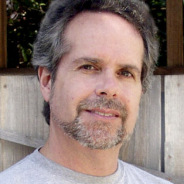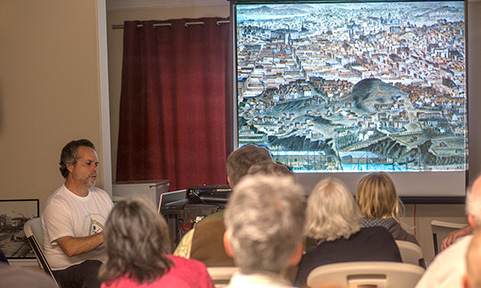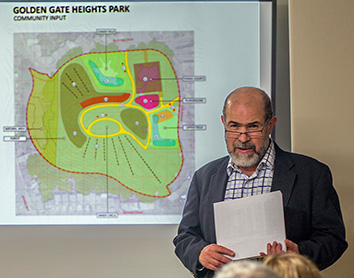Monday, June 30, 2014

Our featured speaker, Craig Dawson, Executive Director of Sutro Stewards, provided a fascinating glimpse of the Mt. Sutro Open Space Reserve, including its cultural history, management, and current and future challenges faced by this 61-acre local treasure.
In the 1800’s, the area had a high elevation of 1,087 feet and was part of a privately owned tract of land called Rancho San Miguel. In those days, everything west of the city proper was called the “outside lands,” and these included what are now known as the Sunset, Haight, and Richmond neighborhoods. Mt. Sutro itself was originally called Blue Mountain but its name was changed in the early 1900’s, after Adolph Sutro had purchased Rancho San Miguel and began to plant trees on it. In a few decades, the area had turned into a dense forest. Sutro donated 13 acres of land to the Affiliated Colleges, which later became UCSF. In 1953 UCSF bought another 90 acres of Sutro’s forest, which was incorporated into the Campus, the Aldea Student Housing and Open Space. In a few decades, the area had turned into a forest. The land eventually was donated for the UCSF/Parnassus Campus.
During the depression, the forest began to be thinned; extensive logging of eucalyptus trees provided badly needed jobs. Mr. Dawson shoed a photograph of the totally denuded hills that became the streets of Midtown Terrace in 1955. UCSF built student housing north of the area cleared for Clarendon Avenue, and in the 1950’s the military controlled the summit with a high security Nike radar site. Between the 1930’s and the 1950’s, the summit lost over 100 feet of altitude and no longer exceeds 1000 feet.
Currently, UCSF still owns Sutro Forest, which is now clogged with ivy and Himalayan blackberry bushes. Because of the ongoing lack of forest husbandry, the understory has become thick with shade loving weeds and thin, spindly trees that get no light. A team of forestry consultants brought in by UCSF estimated that the forest now contains over 700 trees per acre (note that the Presidio Trust has a stated goal of about 50 trees per acre for the Presidio).
Mr. Dawson showed dramatic examples of trees riddled with diseases such as anthracnose, snout beetle, tortoise beetle heart (sap) rot from fungi, wood decay fungi, and phytophtora. The forest is suffering, and one of the potential side effects of the lack of attention is the risk of fire.
In 2013, UCSF announced a plan to create a fire mitigation area, but the plan would essentially destroy a large amount of wildlife habitat. A preferable approach would include “adaptive management,” which permits for implementation of a plan that can be adapted as needed. UCSF states its views and activities on its web page regarding Mt. Sutro.
Sutro Stewards is a grassroots organization that works to restore multi-use trails, attend to the forest’s health, and ensure an appropriate wildlife habitat. Part of its mission is to educate volunteers. For additional information, contact www.sutrostewards.org.
Frank Noto gave a brief presentation at the start of the evening about the proposed improvements, upgrades, and repairs to Golden Gate Heights Park. He was capably aided by Jason Macario, who provided visuals. Among other problems, the park has a failing playground that contains outdated arsenic-laden playground equipment; this may be replaced under the failing playgrounds program. Golden Gate Heights Neighborhood Association (G.G.N.H.A.) has taken the lead in fundraising and applying for city funds for a proposal to fix faulty drainage, repave part of the existing walking path, fix the tennis courts, and remediate other problems. The budget for the work proposed, a fraction of what would ideally be needed to fully restore and upgrade the park, is $400,000. Recently, the park won $23,000 from the District 7 participatory budgeting process, in which neighborhood residents were invited to vote for worthy projects in the various districts. The park actually got more votes than any other project in the city! However, a certain percentage of the money required has to be raised by the community. S.H.A.R.P. has endorsed the project and recently donated $1,000 to the park fund. We encourage all our members and followers to take an action in support of this important endeavor, whether by making a cash donation (which can be made through G.G.H.N.A.) or by volunteering some time. (The city values each hour of volunteer time at $25.25 per hour!) We’ll publicize upcoming volunteer opportunities on our website. Any questions? Contact S.H.A.R.P. or G.G.N.H.A.

